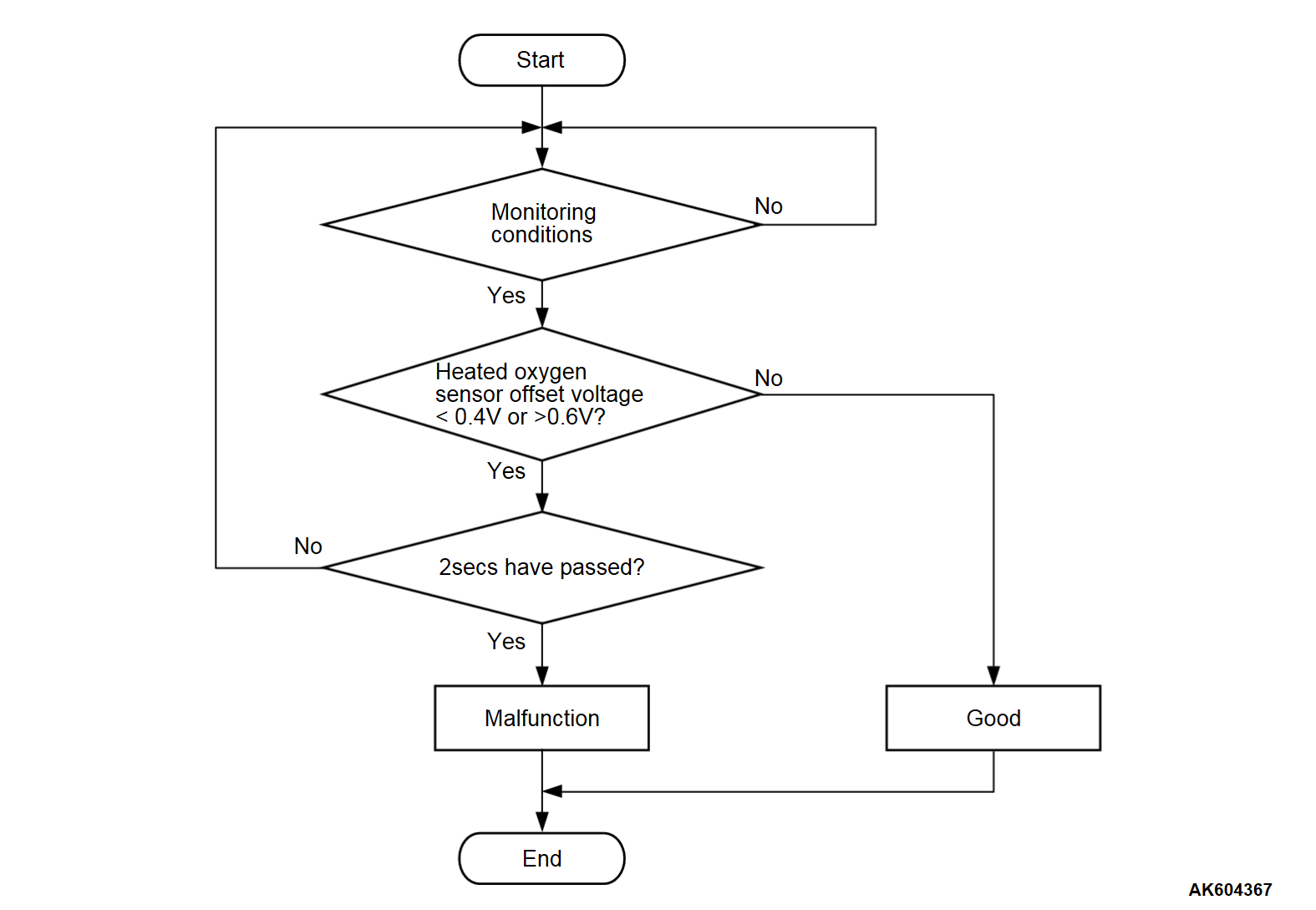DTC P2252: Heated Oxygen Sensor Offset Circuit Low Voltage
HEATED OXYGEN SENSOR OFFSET CIRCUIT LOW VOLTAGE CIRCUIT
CIRCUIT OPERATION
TECHNICAL DESCRIPTION
- The ECM applies an offset voltage of 0.5 volt to the heated oxygen sensor.
- The ECM checks for heated oxygen sensor offset voltage.
DESCRIPTIONS OF MONITOR METHODS
- Heated oxygen sensor offset voltage is under specified range.
MONITOR EXECUTION
- Continuous
MONITOR EXECUTION CONDITIONS (Other monitor and Sensor)
Other Monitor (There is no temporary DTC stored in memory for the item monitored below)
- Not applicable
Sensor (The sensor below is determined to be normal)
- Not applicable
DTC SET CONDITION
Check Condition
- 2 seconds or more have passed since the engine starting sequence was completed.
Judgment Criterion
- Heated oxygen sensor offset voltage is lower than 0.4 volt for 2 seconds.
FAIL-SAFE AND BACKUP FUNCTION
- None
TROUBLESHOOTING HINTS (The most likely causes for this code to be stored are: )
- Right bank heated oxygen sensor (rear) failed.
- Left bank heated oxygen sensor (rear) failed.
- Shorted right bank heated oxygen sensor (rear) circuit or connector damage.
- Shorted left bank heated oxygen sensor (rear) circuit or connector damage.
- ECM failed.
DIAGNOSIS
Required Special Tools:
- MB992744: Vehicle Communication Interface-Lite (V.C.I.-Lite)
- MB992745: V.C.I.-Lite Main Harness A
- MB992747: V.C.I.-Lite USB Cable Short
- MB992748: V.C.I.-Lite USB Cable Long
- MB991958: Scan Tool (M.U.T.-III Sub Assembly)
- MB991824: Vehicles Communication Interface (V.C.I.)
- MB991827: M.U.T.-III USB Cable
- MB991910: M.U.T.-III Main Harness A (Vehicles with CAN communication system)
- MB991316: Test Harness
- MD998464: Test Harness
STEP 1. Check the right bank heated oxygen sensor (rear).
(1) Disconnect the right bank heated oxygen sensor (rear) connector and connect test harness special tool MD998464 to the connector on the right bank heated oxygen sensor (rear) side.
(2) Warm up the engine until engine coolant temperature reaches 80°C (176°F) or higher.
(3) Drive at 50 km/h (31 mph) or more for 10 minutes.
(4) Connect a digital voltage meter between terminal ORRE line (black clip) and terminal O2RR line (white clip).
(5) Measure the output voltage of heated oxygen sensor under the following driving.
- Transaxle: 2nd speed
- Drive with wide open throttle
- Engine: 3,500 r/min or more
Standard value: 0.6 - 1.0 V
| note | If the temperature of sensing area does not reach the high temperature [of approximately 400°C (752°F) or more] even though the heated oxygen sensor is normal, the output voltage would be possibly low in spite of the rich air-fuel ratio. |
| note | When the vehicle is driven with high loads, the temperature of the sensing area of the heated oxygen sensor is sufficiently high. Thus, it is not necessary to apply the voltage to the heater. |
Is the measured voltage between 0.6 and 1.0 volt?
STEP 2. Check the left bank heated oxygen sensor (rear).
(1) Disconnect the left bank heated oxygen sensor (rear) connector and connect test harness special tool MB991316 to the connector on the left bank heated oxygen sensor (rear) side.
(2) Warm up the engine until engine coolant temperature reaches 80°C (176°F) or higher.
(3) Drive at 50 km/h (31 mph) or more for 10 minutes.
(4) Connect a digital voltage meter between terminal ORLE line (black clip) and terminal O2RL line (white clip).
(5) Measure the output voltage of heated oxygen sensor under the following driving.
- Transaxle: 2nd speed
- Drive with wide open throttle
- Engine: 3,500 r/min or more
Standard value: 0.6 - 1.0 V
| note | If the temperature of sensing area does not reach the high temperature [of approximately 400°C (752°F) or more] even though the heated oxygen sensor is normal, the output voltage would be possibly low in spite of the rich air-fuel ratio. |
| note | When the vehicle is driven with high loads, the temperature of the sensing area of the heated oxygen sensor is sufficiently high. Thus, it is not necessary to apply the voltage to the heater. |
Is the measured voltage between 0.6 and 1.0 volt?
STEP 3. Check of short circuit to ground in ORRE line between right bank heated oxygen sensor (rear) connector and ECM connector.
Is the harness wire in good condition?
STEP 4. Check of short circuit to ground in ORLE line between left bank heated oxygen sensor (rear) connector and ECM connector.
Is the harness wire in good condition?
![[Previous]](../../../buttons/fprev.png)
![[Next]](../../../buttons/fnext.png)



